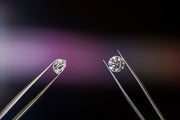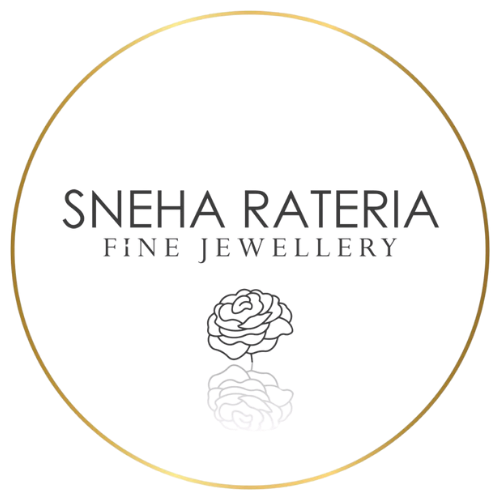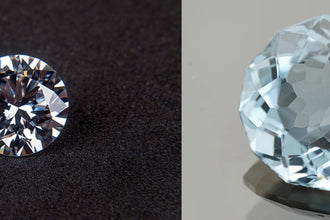
Choosing between lab-grown diamonds and cubic zirconia in the world of jewelry can be confusing, as both options provide stunning, diamond-like beauty. However, they differ significantly in terms of composition, durability, and cost. Understanding these distinctions is essential for making an informed decision that suits your needs. This article will help you understand the characteristics of lab-grown diamonds and cubic zirconia, and examine the benefits and drawbacks of selecting lab-grown options for your jewelry collection.
What Are Lab-Grown Diamonds?
Lab-grown diamonds, also known as synthetic diamonds or cultured diamonds, are real diamonds created in a laboratory environment using advanced technology. These diamonds are chemically, physically, and optically identical to natural diamonds mined from the earth.
What Is Cubic Zirconia?
Cubic zirconia (CZ) is a popular synthetic gemstone that serves as an affordable alternative to diamonds. It is composed of zirconium dioxide and was first developed in Russia in the 1970s. Since then, it has gained popularity in the jewelry market due to its diamond-like appearance and lower cost.
Differences Between Lab-Grown Diamonds and Cubic Zirconia
Here are the key differences between lab-grown diamonds and cubic zirconia:
1. Chemical Structure
- Lab-grown diamonds are made of pure carbon, just like natural diamonds mined from the earth.
- Cubic zirconia is made from zirconium dioxide (ZrO2) and contains no carbon.
2. Hardness
- Diamonds, including lab-grown, are the hardest known natural material, rating 10 on the Mohs hardness scale.
- Cubic zirconia is softer, rating 8-8.5 on the Mohs scale, making it more prone to scratches and damage.
3. Durability
- Lab-grown diamonds have the same durability and hardness as natural diamonds, making them very scratch-resistant.
- Cubic zirconia is less durable and has a tendency to become cloudy or lose its shine over time.
4. Color
- Lab-grown diamonds come in a range of colors, from colorless to fancy colors like yellow, pink, and blue.
- Cubic zirconia is usually colorless in its natural state but can be color-treated to mimic fancy colored diamonds.
5. Price
- Lab-grown diamonds are generally more affordable than natural diamonds but can still be quite expensive, especially for higher carat weights and superior quality.
- Cubic zirconia is significantly cheaper than both natural and lab-grown diamonds, making it a cost-effective alternative for those seeking the look of a diamond without the high price tag.
6. Certification
- Lab-grown diamonds can be certified by reputable gemological labs like GIA, just like natural diamonds.
- Cubic zirconia is not certified, as it is considered a diamond simulant rather than a real diamond.
Benefits of Lab-Grown Diamonds
1. Affordability: Lab-grown diamonds are typically less expensive than natural diamonds, making them more accessible to a wider range of consumers.
2. Ethical and Environmentally Friendly: Lab-grown diamonds are conflict-free and produced without the environmental impact associated with mining natural diamonds.
3. Customization: Lab-grown diamonds can be produced in a variety of colors, including rare and fancy colors, which are often more expensive in natural diamonds.
Lab-Grown Diamonds: Pros and Cons
Pros of Lab-Grown Diamonds
1. Affordability: Lab-grown diamonds are typically 30-50% cheaper than their mined counterparts, allowing consumers to purchase larger or higher-quality stones within their budget.
2. Ethical Sourcing: Created in controlled environments, these diamonds significantly reduce the risk of human rights abuses and labor exploitation often associated with diamond mining.
3. Environmental Impact: Lab-grown diamonds generally have a lower environmental footprint compared to mined diamonds. The production process avoids extensive land disruption and ecological damage caused by mining activities. Additionally, many labs now use renewable energy sources in their production.
4. Customization Options: Consumers benefit from a wider range of choices in terms of size, color, and design. Lab-grown diamonds can be tailored to specific preferences, making them versatile for various jewelry styles.
5. Transparency: Lab-grown diamonds come with certifications that guarantee their quality and origin. This transparency allows buyers to make informed decisions about their purchases.
Cons of Lab-Grown Diamonds
1. Perceived Value: Some people consider lab-grown diamonds less valuable than natural diamonds due to their artificial origin, affecting their desirability and emotional significance.
2. Lower Resale Value: Lab-grown diamonds typically have lower resale values compared to mined diamonds. As supply increases, their market value may decrease, making them less of a long-term investment.
3. Energy Consumption: The production of lab-grown diamonds is energy-intensive, which can undermine their sustainability claims. Methods such as High Pressure High Temperature (HPHT) and Chemical Vapor Deposition (CVD) require significant amounts of energy and resources.
4. Limited Rarity: Unlike natural diamonds, which form over billions of years and are finite in supply, lab-grown diamonds can be produced in large quantities. This mass production diminishes their uniqueness and the emotional connection some consumers seek in their jewelry.
5. Impact on Traditional Mining Communities: The rise of lab-grown diamonds may negatively affect communities that rely on diamond mining for their livelihoods. As demand shifts, these communities could face economic challenges.
Why Choose Lab-Grown Diamond Rings
Lab-grown diamond rings are an exciting and meaningful choice for anyone looking to celebrate love and commitment. These diamonds are created in controlled environments using advanced technology, making them virtually identical to natural diamonds in beauty and quality. Choosing a lab-grown diamond means you can enjoy a stunning ring at a lower price, allowing you to invest more in your future together.
Additionally, lab-grown diamonds are an eco-friendly option, as they have a smaller environmental impact and are conflict-free, ensuring that your purchase supports ethical practices. With their brilliance and ethical appeal, lab-grown diamond rings offer a perfect blend of luxury and responsibility.
Conclusion
When deciding between lab-grown diamonds and cubic zirconia, consider your budget, the importance of durability, and the type of appearance you desire. Lab-grown diamonds offer a more authentic and lasting option, while cubic zirconia provides a budget-friendly alternative that still looks beautiful. Understanding these differences will help you choose the best option for your jewelry needs.
FAQs
1. Are lab-grown diamonds real diamonds?
Yes, lab-grown diamonds are real diamonds, chemically and physically identical to natural diamonds.
2. How are lab-grown diamonds created?
They are produced using two primary methods: High Pressure High Temperature (HPHT) and Chemical Vapor Deposition (CVD).
3. Can cubic zirconia be mistaken for diamonds?
Yes, cubic zirconia can closely resemble diamonds but lacks the hardness and brilliance of real diamonds.
4. Are lab-grown diamonds available in different colors?
Yes, lab-grown diamonds can be produced in various colors, including pink, blue, and yellow, through controlled processes.
5. Can jewelers tell if a diamond is lab-created?
Most jewelers may not be able to distinguish lab-created diamonds from natural ones without specialized equipment.
6. Are there any certifications for cubic zirconia?
Cubic zirconia does not have formal certifications like diamonds, but reputable sellers will provide information on quality and origin.
7. How do I know if a diamond is lab-grown?
Look for a grading report from a reputable gemological lab that specifies whether the diamond is lab-grown or natural.
8. What is the lifespan of cubic zirconia?
Cubic zirconia can last several years but may scratch or lose its brilliance over time, unlike diamonds which can last a lifetime.
9. Can lab-grown diamonds be used in engagement rings?
Absolutely! Lab-grown diamonds are a popular choice for engagement rings due to their beauty and ethical considerations.
10. Can cubic zirconia be recut or repurposed?
Yes, cubic zirconia can be recut or repurposed, but it is less common due to its lower value compared to diamonds.







